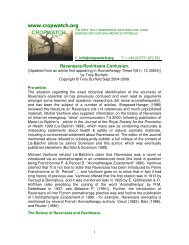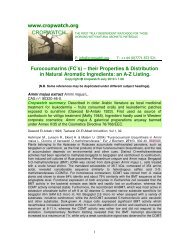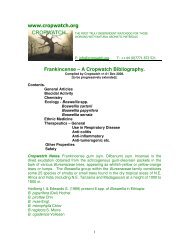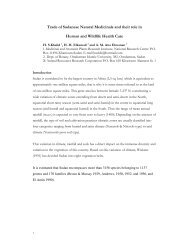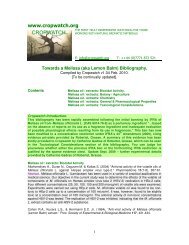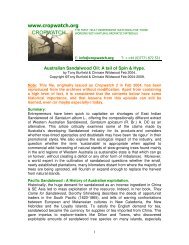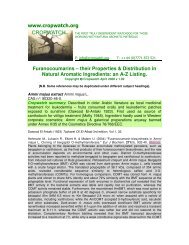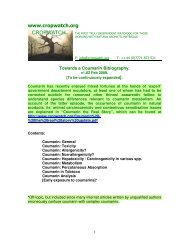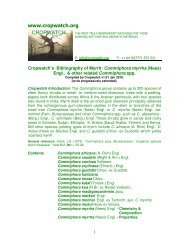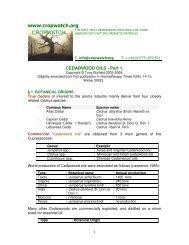Sandalwood Biblio - Cropwatch
Sandalwood Biblio - Cropwatch
Sandalwood Biblio - Cropwatch
Create successful ePaper yourself
Turn your PDF publications into a flip-book with our unique Google optimized e-Paper software.
Florento A. (1997) “<strong>Sandalwood</strong> oil faces trouble as crop is destroyed by fire” Chemical Marketing<br />
Reporter March 31, 1997.<br />
Fox J.E.D.. (2000) “<strong>Sandalwood</strong>: the royal tree” Biologist London 47(1), 31-34. Abstract.<br />
<strong>Sandalwood</strong> is the most valuable tree in the world. As with gold, platinum and diamonds, it owes<br />
its value to a demand based on ritual, fashion and scarcity. It is the stuff of mystery and intrigue,<br />
and fortunes can still be made from it.<br />
Fragrance raw materials monographs (1974): “<strong>Sandalwood</strong> oil, East Indian.” Food & Cosmetics<br />
Toxicology 12(7-8), 989-990.<br />
Gjerum L., Fox, J.E.D. & Ehrhart L., (eds) (1995) <strong>Sandalwood</strong> Seed Nursery and Plantation<br />
Technology FAO, Suva. RAS/92/2361. Field Document No.8.<br />
Gleason J. (2009) “Comparing notes: Formulating with coumarin, sandalwood & ethyl linalool: an<br />
extended conversation with fine fragrance perfumers Kevin Verspoor & Pierre Gueros.”” Perf &<br />
Flav 34, April 2008, pp26-29. <strong>Cropwatch</strong> comments: In spite of the promising title, one short<br />
section on sandalwood tells you littlethat you probably didn’t know already, namely that<br />
sandalwood oil E.I. can be used in almost every type of perfume, making it full and long-lasting,<br />
and it is difficult to overdose.”.<br />
Griffith W (1836). "On the ovulum of Santalum album." Transactions ofthe Linnean Society of<br />
London (Botany) 18, 59-70.<br />
Haffner D. (1993). “Determining heartwood formation within Santalum album and Santalum<br />
spicatum.” <strong>Sandalwood</strong> Research Newsletter 1, 4–5.<br />
Hart H.H. & Schoemfelt F. (1956) “Some seed fats of Santalaceae & Oleaceae.” Aust J Chem 12,<br />
190.<br />
Haque M.H. & Haque A.U. (date) United States Patent 6406706; EP Patent 1,059,086, 2000<br />
"Use of α- and β-santalols major constituents of sandal wood oil, in the treatment of warts, skin<br />
blemishes and other viral-induced tumors." Abstract. The present invention provides a method for<br />
the treatment of viral-induced tumors in mammals, more specifically, human warts. The method<br />
uses α- and β-santalols, or mixtures or derivatives thereof, to prepare medicaments for the<br />
treatment of viral-induced tumors i.e., warts caused by the human papillomavirus (HPV) in<br />
humans. The method of the invention comprises the topical administration of α- and β-santalols,<br />
or mixtures or derivatives thereof, in a composition derived therefrom, to the human epidermis, as<br />
needed. The present invention is also concerned with a unique antiviral composition useful for<br />
topical application. The antiviral composition according to this invention is also effective against<br />
other DNA viruses such as the DNA pox virus that causes Molluscum contagiosum and may be<br />
effective against other DNA viruses such as AIDS virus and RNA viruses. The α- and β-santalols<br />
composition, or mixtures or derivatives thereof, may also be effective in the treatment of genital<br />
warts and HPV of the genital tract and in the treatment of cancer of the skin and cervix. The α-<br />
and β-santalols, or mixtures or derivatives thereof, may also be effective in the prevention of<br />
dryness of the skin, rashes and flakiness associated with seborrheic dermatitis, psoriasis and<br />
allergic or eczematous rashes of the skin. The α- and β-santalols, or mixtures or derivatives<br />
thereof, may also be effective in the treatment of acne lesions of the face and the body and in the<br />
eradication of pustular acne lesions caused by staphylococcal acne and streptococcal bacterial<br />
infections.<br />
Henfrey A (1856). "On the develop-ment of Santalum album." Transac-tions of the Linnean<br />
Society of Lon-don (Botany) 22, 69-79.<br />
Heuberger E., Hongratanaworakit T. & Buchbauer G. (2001) “Biological properties of the<br />
essential oil of East Indian sandalwood (Santalum album L.) and its main compounds alpha- and<br />
beta-santalol.” Oral presentation 4éme Symposium Internat. D’Aromatherapie Scientifique, March<br />
2001, Grasse, France.<br />
46





